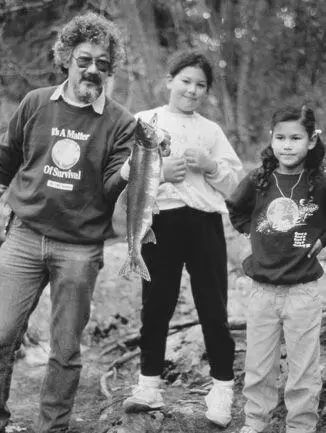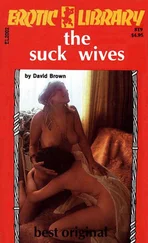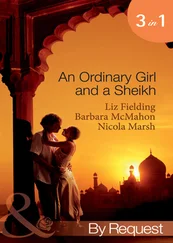Alan Wilson, a Haida hereditary chief, was one of the Royal Canadian Mounted Police officers at the protest line at Windy Bay. He had been caught in an agonizing position — he understood that the confrontation was about the land that made the Haida who they are, yet as an RCMP officer, he had to enforce the laws of the dominant society. The three elders who had insisted they be the ones to block the road and be arrested included his own aunt, Ethel Jones. Alan had approached the elders with tears streaming down his face in a scene that would appear on national television. “It's all right, dear,” his aunty assured him as she took his arm and walked to the helicopter that would whisk her away to jail.
Alan leaped up at the Skidegate feast and publicly announced that he was giving me his dance apron, part of the formal regalia. Decorated with strips of copper, buttons, and figures of whales and birds, it was the first piece of regalia I ever received and is a much-treasured gift. Each time I wear it, great memories flood back.
The Gwaii Haanas National Park Reserve and Haida Heritage Site agreement was signed in January 1993, after almost six years of negotiation between Canada and the Haida Nation. The official title recognizes that the Haida designated Gwaii Haanas a Haida Heritage Site in 1985.
ANOTHER BATTLE THAT TOOK place during this period was the fight to protect the Stein Valley, at 425 square miles the last large unlogged watershed in southwestern B.C., relatively close to Vancouver.
In 1984, I received a request from organizer John McCandless on behalf of Chief Ruby Dunstan of the Lytton First Nations band and Chief Leonard Andrew of the Lil'wat band to speak at the first of what it was hoped would become an annual festival to celebrate and protect the Stein Valley. The First Nations who had roamed the valley for thousands of years claimed it as a spiritual place. Unfortunately, I had a previous commitment at the time of the inaugural festival in 1985 and was unable to make it, but John invited me early so that I could attend the next year.
John was an American who had left his country during the Vietnam War; he ended up moving his family to the Fraser Valley in B.C. and working for the Lytton band. As was common practice in British Columbia at that time, a forest company had been granted a license to log the Stein Valley, without any consultation or approval from the people who had been using it for their sacred burial sites and as a source of berries and salmon long before Europeans arrived. Environmentalism was growing in British Columbia, aided by the high-profile fight against clear-cut logging by the Haida.
John had conceived of the idea of raising the profile of the Stein Valley by holding a First Nations — run festival that would feature speakers and musicians. That first gathering attracted up to five hundred people, who hiked high into the alpine at the valley headwaters in a terrific kickoff to what would become an incredible success.
What impressed me over the years was John's ability to manage all the details required to hold the Stein Valley Festival. He eventually inspired the support of hundreds of skilled volunteers from the two host communities, but try to imagine the logistics involved in pulling off a celebration that hundreds (eventually tens of thousands) of people would attend in a very remote and wild part of B.C. Posters and advertising had to be arranged; parking sites had to be found for hundreds of vehicles; trails had to be cut for hikers. As the success of the festival grew, loggers went in and felled several huge trees across the path of hikers, creating a lot of tension over possible violence. Campsites and cooking facilities were needed; food was arranged for special guests, elders, and staff; portable toilets had to be installed before the festival and removed after; first aid was necessary for everything from sunburn to broken bones; a stage and a sound system were needed for performers; garbage had to be dealt with; elders and VIPs who couldn't hike had to be helicoptered to campsites; tepees were set up for special guests; guards were recruited in case of confrontations with loggers or rednecks, and cleanup crews were needed during and after the event. And, of course, the money had to be raised. It was like mounting a major battle, but somehow, with the help and direction of chiefs Dunstan and Andrew, year after year John pulled it off.

Sev, Guujaaw, and Tara at a Stein Festival in the alpine meadows
For the second festival, Tara and I were delighted to have the chance to camp in a part of the province we hadn't seen before. The festival site was alongside the lower Stein River, in a meadow, and there might have been a couple of hundred people there. In preparing for my talk, I had to integrate my ideas about the environment with what little I knew about the traditional values of First Nations.
The first night, Tara and I and our two very young daughters were put up in a large tepee with several other people. We had settled comfortably into our sleeping bags and were about to drop off when a group right outside the tepee began to drum and chant. For hours! Tara was beside herself with frustration at first, but in the end our daughters slept through it all. The night grew bitterly cold, the drumming and singing droned on, the wind blew the dry soil under the edges of our tepee, and we felt so far from our world that we were finally transported to a different state: we knew this was a watershed experience in our lives.
In the next tepee were Miles Richardson, the young, charismatic president of the Haida Nation, involved in his own battle over the land; Patricia Kelly, his Coast Salish girlfriend; and Guujaaw, the Haida artist who played such an important role in my education and who would himself become president after leading the fight against logging in Haida Gwaii. They would become our dearest friends and companions over the years.
Time changed for us. The drumming continued through the night as we drifted between our dreams and the people outside. The lead drummer was a young man who called himself “Seeker,” and in the following days, Tara and I found he had much to teach us. He told us the reason this valley was important to him and his people. “White people go to church, but I come here. When I bring my kids here,” he told us, “all my problems fall away and I feel at peace. This is my sanctuary.” I began to understand what the word “sacred” means.
Because of its relative proximity to Vancouver, the Stein Valley became a favorite place for my family to hike and fish. When Sarika was six, we backpacked along the river one Thanksgiving. We reached the Devil's Staircase, a steep climb over a rocky scree that was a formidable challenge for the children. As we began to climb, Sarika lay down on the trail and refused to go any farther. I took the pack off her back and urged her on for a few hundred yards, at which point she stopped and refused to go on. I ended up carrying not just her pack but Sarika herself until we got over that hump. But she has never refused a hiking challenge since.

Severn and Sarika admiring a spawned-out chum salmon in the Stein Valley
Thanks to the increasing attendance at the festival, interest in the Stein Valley grew. The environmental community rallied to the cause. Colleen McCrory of the Valhalla Wilderness Society in New Denver, B.C., had successfully led a fight to have the area where Dad and I fished while at the wartime camps in the Slocan Valley set aside as Valhalla Provincial Park, and she took part in the later Stein festivals. The Western Canada Wilderness Committee, one of the oldest and most effective grassroots activist organizations in B.C., had pioneered the issue and continued to pitch in with posters and papers publicizing the Stein.
Читать дальше




![David Jagusson - Devot & Anal [Hardcore BDSM]](/books/485905/david-jagusson-devot-anal-hardcore-bdsm-thumb.webp)









